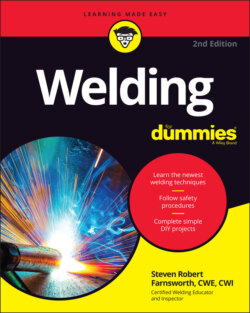Читать книгу Welding For Dummies - Steven Robert Farnsworth - Страница 3
Welding For Dummies® To view this book's Cheat Sheet, simply go to www.dummies.com and search for “Welding For Dummies Cheat Sheet” in the Search box. Table of Contents
Оглавление1 Cover
2 Title Page
3 Copyright
4 Introduction About This Book Conventions Used in This Book What You’re Not to Read Foolish Assumptions How This Book Is Organized Icons Used in This Book Where to Go from Here
5 Part 1: Understanding Welding Basics Chapter 1: Diving Into the World of Welding If You Can’t Beat ’Em, Join ’Em: Understanding Why Welding Matters Getting Familiar with Metals Taking the Time to Understand Welding Safety Exploring Welding Methods Looking at the Future of Welding Chapter 2: Considering Commonly Welded Metals Steeling Yourself for Using Steel Going with Stainless Steel Working with Aluminum Considering Other Metals Chapter 3: Setting Your Sights on Welding Safety Gearing Up to Protect Yourself Observing Basic Safety Rules Being Prepared for Injuries and Accidents Chapter 4: Setting Up Your Welding Shop Choosing a Location Equipping Your Welding Shop
6 Part 2: Welding on a Budget: Stick and Tig Welding Chapter 5: Getting on the Stick: Understanding Stick Welding Looking at the Pros and Cons of Stick Welding Understanding the Factors That Influence Stick Welding Getting Familiar with Stick Welding Equipment Chapter 6: Getting to Work with Stick Welding Preparing to Stick Weld Setting the Machine Striking and Maintaining an Arc Assume the Position: Stick Welding in All Positions Chapter 7: To Tig or Not To Tig: Understanding Tig Welding Taking a Closer Look at Tig Welding Components Considering the Advantages and Disadvantages of Tig Welding Brushing Up on Tig Welding Basics Stocking the Shop: Examining Tig Welding Equipment Chapter 8: Trying Out Tig Welding Getting Your Welding Setup Tig-ether Matching Materials and Settings Getting a Handle on Using Your Tig Torch Giving Tig Welding a Try
7 Part 3: Discovering Mig Welding Chapter 9: Understanding the ABCs of Mig Welding Understanding How Mig Welding Works Considering Mig Welding’s Advantages and Limitations Bringing Out the Big Guns (And Other Mig Welding Equipment) Sifting Through Shielding Gases for Mig Welding Taking a Look at Electrode Wire Adjusting Mig Equipment to Suit Your Mig Welding Project Chapter 10: Practicing Mig Welding Preparing to Mig Weld Trying Out Mig Welding Watching Out for Common Mig Welding Defects
8 Part 4: Getting Fancy: Plasma Cutting, Oxyfuel Cutting, and Other Processes Chapter 11: Examining Plasma and Oxyfuel Cutting Understanding Plasma Arc Cutting Perusing and Preparing Plasma Arc Cutting Equipment Exploring Oxyfuel Cutting Basics Checking Out and Setting Up Oxyfuel Cutting Equipment Chapter 12: Ready, Set, Cut! Trying Out Plasma Arc Cutting and Oxyfuel Cutting Exploring Plasma Arc Cutting Practicing Oxyfuel Cutting Chapter 13: Exploring Special Weld Processes Working Through the Basics of Welding with Gas Discovering Brazing (Braze Welding) Finding Out about Fusion Welding Soldering On: Exploring Soldering Chapter 14: Exploring Pipe Welding Delving into the Different Kinds of Pipe Getting Down to Welding Steel Pipes Peeking at a Few More Types of Pipe Welding Joints Keeping an Eye Out for Common Pipe Welding Defects Chapter 15: Working with Cast Iron Casting Light on the Three Most Common Types of Cast Iron Getting the (Cast) Iron in the Fire: Welding Gray Cast Iron
9 Part 5: Putting Welding into Action with Projects and Repairs Chapter 16: Two Welding Projects to Boost Your Welding Shop Creating a Torch Cart Fabricating Your Own Portable Welding Table Chapter 17: Constructing a Campfire Grill Fabricating a Campfire Grill Chapter 18: Fixin’ to Fix Things: Analyzing and Planning Determining Whether Something Is Fixable Planning a Repair Strategy Getting Ready to Make Repair Welds Considering Cracks
10 Part 6: The Part of Tens Chapter 19: Ten Tools Every Welder Wants 4½-Inch Grinder Hacksaw Air Compressor ⅜-Inch Electric Drill Wrench Set Steel Sawhorses Cutoff Saw Bench Grinder Bottle Jack Toolbox Chapter 20: (Not Quite) Ten Advantages of Being a Certified Welder More Job Opportunities Better Pay More Chances for Advancement Certification that Travels with You Ability to Join a National Organization Qualification in Specific Areas of Welding Increased Confidence in Your Welding Skills Listing in the American Welding Society Database A Head Start on Additional Types of Welding Certification Chapter 21: (Almost) Ten Welding Defects Incomplete Penetration Incomplete Fusion Undercutting Slag Inclusions Flux Inclusions Porosity Cracks Warpage Spatter Chapter 22: Ten Signs You’re Welding Correctly The Weld Is Distributed Equally between Parts The Slag or Shielding Material Doesn’t Stick to the Weld No Holes or Irregularities on the Weld Surface The Weld Is Tight The Weld Is Leakproof The Weld Has Full Penetration The Weld Has No Undercutting The Weld Has No Overlap The Weld Meets Strength Requirements You’re Safe and Healthy Chapter 23: Ten Maintenance Tips for Your Welding Equipment and Shop Checking on Your Hand Tools Taking Care of Power Tools Doing Basic Housekeeping in the Shop Protecting Your Welding Helmet Seeing to Stick Welding Machine Maintenance Working on Maintaining Your Mig Welding Machine Tuning Up Your Tig Welding Machine Taking Care of Your Oxyfuel Equipment Keeping Your Air Compressor Working Drill Press Maintenance
11 Glossary
12 Index
13 About the Author
14 Connect with Dummies
15 End User License Agreement
